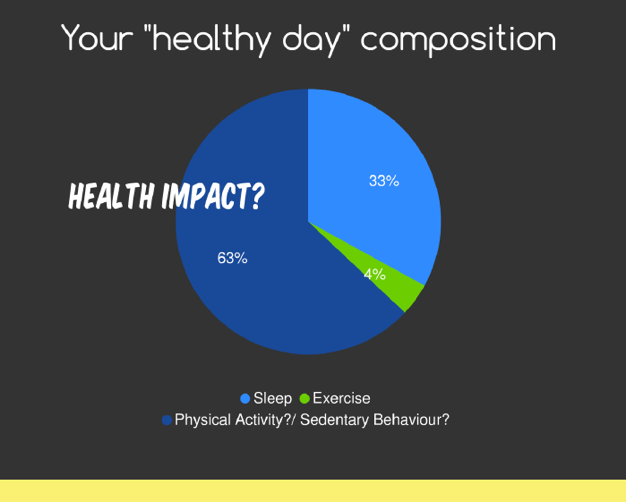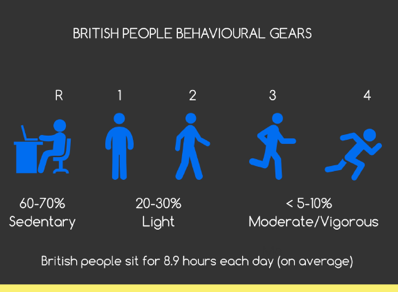
Today is “On your feet Britain Day “, an initiative by Get Britain Standing to bring awareness to the benefits of moving during your working day. The perfect day to ask you to reflect on your “behavioural gear” !
As a nutritionist, I often talk to my clients about the “healthy plate composition” but today I would like to focus on your “healthy day composition”.
How should your day composition look like to provide you with the best possible health outcome and physical and mental energy?
Let’s think about this:
The World Health Organization Global Recommendations on Physical Activity for Heath (2010) states that
“Adults aged 18–64 should do at least 150 minutes of moderate-intensity aerobic physical activity throughout the week or do at least 75 minutes of vigorous-intensity aerobic physical activity throughout the week or an equivalent combination of moderate- and vigorous-intensity activity.
Aerobic activity should be performed in bouts of at least 10 minutes duration.”
150 minutes per week = 2% of your daily time =
= decreased risk of disease
…but if you want to go from disease avoidance towards optimal health
“For additional health benefits, adults should increase their moderate-intensity aerobic physical activity to 300 minutes per week, or engage in 150 minutes of vigorous-intensity aerobic physical activity per week, or an equivalent combination of moderate- and vigorous-intensity activity.
Muscle-strengthening activities should be done involving major muscle groups on 2 or more days a week.”
300 minutes per week = 4% of your time =
= improved energy, moods and long term health
If all it take is only 4% of our daily hours (although the majority of people in UK even struggle to find that time and stick to that commitment) …what about the remaining 98-96% of the day?
We know about the importance of sleep and that we should dedicate at least 1/3 of our day to it (≈ 8 hours). So, let’s say 33% of our day is dedicated to good quality, restoring sleep…
What about the remaining 65-63% of our time?
What about its contribution to your health and energy levels?
Does the way we choose to spend that time bear no impact at all on our health and energy?
Think about your day and how much of it, excluding your sleep and physical activities, you are typically spending standing and moving and how much you are spending sitting down.
It turns out that sedentary behavior (basically any time you are sitting or lying down, having screen time, driving and reading) has a huge impact on your health and I am sure you have guessed that it is not good news!

Sourced from: Townsend N, Bhatnagar P, Wickramasinghe K et al. Physical activities statistic 2012. London: British Heart Foundation, 2012.
How is your behavioural gear?
Unfortunately, it turns out that, regardless of us meeting the targets for the recommended amount of physical activity, the numbers of daily hour spent being sedentary (sitting) are positively correlated with higher risk of diabetes, cardiovascular disease and some cancers. Sitting for more than 4 hours each day disrupts blood sugar balance, increase insulin and blood pressure levels, reduces metabolic rate (you burn 50 kcal less when sitting compared to standing) and reduce the activity of lipoprotein lipase by 90% (an enzyme which helps breaking down fats) and have a negative impact on muscle mass and strength.
The message from a large body of research conducted in the recent years is very clear and Dr. Stuart Biddle, Professor of Active Living & Public Health, Victoria University, Australia just sums it up nicely by saying:
“Even if you exercise for at least 30 minutes most days, you are still storing up health problems from being sedentary too much.
The message is clear – move more and sit less.”

“For those occupations which are predominantly desk based, workers should aim to initially progress towards accumulation of 2h/day of standing and light activity (walking) during working hours, eventually progressing to a total accumulation of 4 h/day. To achieve this, seated-based work should be regularly broken up with standing-based work, the use of sit-stand desk or the taking of short active standing breaks…”
Sourced from: “The Sedentary office: a growing case for change towards better health and productivity. Expert statement commissioned by Public Health England and the Active Working Community Interest Company “ (2015)
The importance of jiggling and wiggling :
Your action plan to move through your working day
Commuting to the office and back
- On public transport: be polite and give your seat way
- Get off a stop or two earlier and walk the rest of the journey
- Avoid lifts: take the stairs
- Be that person rushing to the top of the escalator …but keep left and keep smiling
- If you drive, take the long way from the car park to your office
- Speed walk to and from your car or bus/underground stop
- Speed walk any errands you might have to do during the day.
In the office
- Stand during phone calls or, even better, pace the office
- Stand and take short breaks from your desk every 30 minutes (set up a telephone reminder)
- Use your ultradian rhythms breaks actively ( go for a walk, do some stretching or some “elegant” desk based exercise)
- Have standing or walking meetings
- Eat your lunch away from your desk
- Do some “Green exercise “ during your lunch break
- Walk to your colleague’s desk instead of phoning or emailing them
- Move your rubbish bin away from your desk
- Use the bathroom that is further away from your desk
- Stand up at the back of the room during presentations
- Replace your desk chair with a stability ball
Elegant stretches and mini workouts at your desk:
- Sitting slightly forward in your chair, rotate your upper body to the right, to reach the right-hand side of the backrest with your left hand. Hold for five seconds, then swap sides
- Loosely grasp your hands behind your neck. Push your elbows back and draw your shoulder blades together. Avoid pressing into the neck. Hold for five seconds
- Interlock your fingers. Push your palms away from your body, gently stretching the forearm muscles, fingers and shoulders blades. Hold for five seconds.
- Reach over your head, bending to the side at your waist and then straighten up. Swap sides and repeat 10 times
Sourced from The Chartered Society of Physiotherapy
You can do all sorts of exercises at your desk but let’s face it… it could be quite awkward so instead of squatting…just start with these subtle mini workouts :
Mini workouts:
- Mini abs workout: suck in your tummy and hold for a count of 10 and repeat 5 times
- Mini gluteus workout: squeeze and hold for a count of 10, release and repeat 5 times.
- Whilst you stand, do calf raises for 30 seconds
Always consider your level of fitness and any physical challenge or injury you might have when implementing changes to your daily physical routine. When adopting more standing-based work you could experience some musculoskeletal sensations and some fatigue as part of the positive adaptive process.
The recommendation from Public Health England suggest to progress toward the accumulation of 2 h/day of standing and light activity during your working day, eventually progressing to a total accumulation of 4 hours per day.
And one last warning and disclaimer…
Be aware:
Being active has been known to cause health and happiness!
Wishing you the best health and vitality,





0 Comments